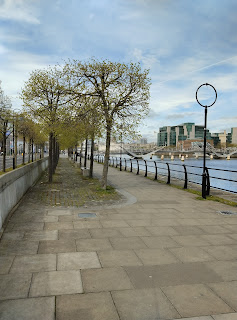April 11th
Today is our last day of wandering and because it's supposed to begin raining at 2PM we've decided to make a long looping walk up Grafton Street to St. Stephen's Green, past the Natural History Museum and National Library around Trinity College, down to the Liffey River, cross the Samuel Beckett Bridge and up the north side of the river to The General Post Office, and then back to our hotel.
[This is where I remind you again that the blog is our personal record of our travels, so the above description of this 5.8 mile walk won't mean much to other readers.]
It feels good knowing that we don't
have to be anywhere. And we know that serendipity will lead us to new discoveries.
 |
The breakfast selections at our hotel.
|
 |
| A barista even makes a coffee of your choice. |
 |
The Molly Malone mythology is
cast in bronze. You can read about
it and listen to the song she's based
on here.
|
 |
| Grafton Street is a pedestrian shopping & busker mecca. |
 |
Marie looked down this lane and
noticed Powerscourt Centre, a place
our walking tour guide mentioned. |
 |
| Today Powerscourt is filled with exclusive shops. |
 |
The original courtyard of this stately
home is now a cafe called Litttle Pyg. |
 |
Back on Grafton Street two Austrian
high schoolers stopped us for a school
assignment. They were surveying
adults, asking 5 questions about their
teenage years. Maxima-Helena is on
the left and Nina to the right and both
live outside Vienna. Their questions
led to an intriguing chat. See what I
mean about serendipity? |
 |
Dublin's coat of arms has 3 castles and
the motto Obedientia, Civium Urbis,
Felicitas translates to "the obedience of
the citizens produces a happy city." The
3 "burning" castles symbolize the zeal
and readiness Dublin's citizens have
for defending it. (base of a street light) |
 |
Leinster House was modeled after our
White House and is the seat of Oireachtas,
Ireland's Parliament. To its left is the
National Library and to the right is the
Natural History Museum. We'll visit both
when we return to Dublin in May. |
 |
| Exhibitions posted in Gaelic... |
 |
and English. We're looking forward
to them when we return. |
 |
| This sign is posted on a gate into one of its entrances. |
 |
| And this was posted on the wall next to it. |
 |
Coffee, beer, writers... we must be
near the college.
|
 |
| Here's that cool cafe again. |
|
| City Quay. We're at the river at last. |
 |
| Jeanie Johnston tall ship, a replica of a famine ship. |
 |
| The Samuel Beckett Bridge is a beauty. |
 |
| I'm sure you noticed it is harp shaped. |
 |
| Typical tie up for tall ships. |
 |
than a museum about the
headquarters of the Easter
Rising. |
 |
On our way back to our hotel we turned down a narrow lane and discovered this and... |
 |
| this, and... (enlarge picture for detail) |
 |
| ...these. |
 |
| On the same lane is this beauty. |
We first visited Dublin in 1996 and it's changed. Here are a few of our observations about those differences.
√ Population in 1996—950,000
√ Population in 2024—1.25 million (300,000 more folks on the streets, not counting tourists. No wonder the city seems full.)
√ There's a lively energy to the crowded streets, and because everybody is friendly and polite, wending along a lane is not stressful.
√ We're pretty sure pubs and coffee shops balance each other. Seattleites would feel right at home here.
√ Dublin hosts tech companies such as Apple, Google, Microsoft, Amazon, and Tenable, a web-based cyber security and vulnerability management platform, I never heard of, and boy is that new. And because Ireland has a low corporate tax rate (12.5%) all the major American banks are in Dublin as well.



































No comments:
Post a Comment